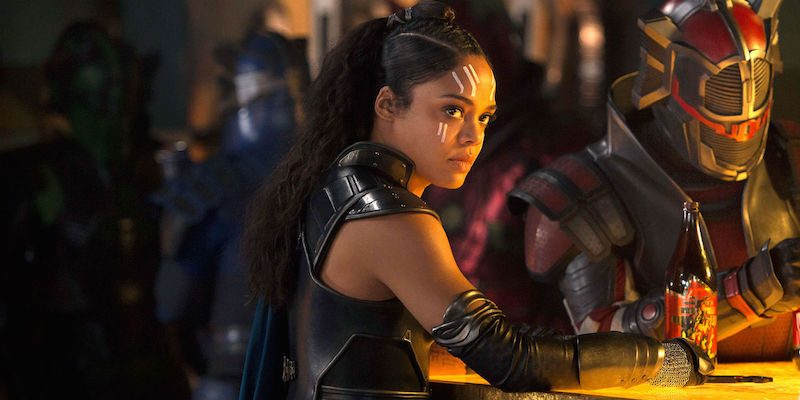Jane Fae examines LGBTQ representation in comic book blockbusters
Two cheers for Thor: Ragnarok, the first major superhero movie featuring an “openly” LGBTQ character. Or, as Tessa Thompson, who plays oh-so-cool never-afraid-of-a-fight Valkyrie tweeted:
She’s bi. And yes, she cares very little about what men think of her. What a joy to play! https://t.co/d0LZKTHCfL
— Tessa Thompson (@TessaThompson_x) October 21, 2017
Following in the footsteps of Wonder Woman, another queer/bi superhero, you might imagine that 2017 was the year when women not only joined the big screen boys in battling cosmic evil, but also came into their own, sexually. Sadly, you would be wrong: 2017 is shaping up to be year of the invisible queer.
As for lesbian types. Hush! Don't frighten the box office.
The problem? Comic books have never been more LGBTQ, with characters such as Karma, the Question and Mystique leading the way. Innovative new series, like Alters and Kim and Kim have showcased bi and trans superheroes, while the Bat-verse alone has given us a lesbian Batwoman (the Kate Kane version) plus two first rank bi baddies in Catwoman and Harley Quinn.
On the small screen, Sarah Lance/White Canary flies the bi flag in DC's Arrow and Legends of Tomorrow series. There are high hopes, too, that Marvel's new Runaways production, due to air in November 2017, will not only major on LGBTQ content, but also break the L barrier with out gay Karolina Dean.
In the movie theatres, however, the idea that a significant woman superhero might be anything other than straight continues to give the moguls indigestion. That doesn't make them a bunch of lesbophobic queer-haters. Quite the opposite. Many of them aren't straight and, given half a chance, they'll happily introduce gay themes.
Like the recent Disney gayness. No, not Beauty And The Beast, but Frozen, in which there seems to be very definite onscreen reference to Trader Oaken and HIS husband!
But then there was that Beauty And The Beast moment: two seconds of dance involving obviously gay LeFou and a man and… the sky falls in. Proposed bans in multiple countries, bans in US cinemas, censors arguing for a restricted certificate.
If you're investing half a billion dollars on a movie property, this you cannot afford. Which is why, however much the studios talk up the “essential bi/queer/pansexuality” of characters, you are unlikely to see it happening for real in any big budget film for years to come.
Instead, we get the likes of Deadpool, “canonically pansexual”, reduced to outrageously camp (and definitely straight). In Suicide Squad, Harley Quinn's bi-ness became straight obsession with the Joker. Elsewhere, Gal Gadot, who played Wonder Woman in 2017, pondered her character's “theoretical” bi-ness.
In interview, she suggested: “It never came to the table, but when you talk theoretically about all the women on Themyscira and how many years she was there, then [it] makes sense.
She adds, "she does not experience any bisexual relationships. But it’s not about that…. She can be bisexual.” Presumably on the days when she is not getting cosy with Steve Trevor.
And now Valkyrie. There is a moment – a brief flashback – where another woman takes the fatal hit destined to end her life that you might just imagine this as the tragic death of her female lover. But otherwise, just a clearing of the decks (Thor has now dropped Jane!) and hints of a possible future love triangle involving Thor, Bruce Banner/the Hulk and Valkyrie.
Of course, it it were true (poly) triangle, anticipating some man to man action between actors Chris Hemsworth and Mark Ruffalo, that would be a thing! But not in your wildest dreams…
For now, however much the studios talk up the LGBTQ content, there isn't any. Nothing. Nada. Zip. Beyond a hint of theoretical bi, and actors internalising their gay, while continuing to play it straight. Two cheers? Maybe I meant one.
How queer is your film?
If you want some idea of just how queer a film actually is, why not try the Vito Russo Test. Following on from the feminist Bechdel Test and named after GLAAD co-founder Vito Russo, this is a tool to help you examine how LGBTQ characters and films are portrayed on screen.
To pass the test, the film must: contain a character who is identifiably LGBTQ, but is not solely or predominantly defined by their sexual orientation or gender identity (i.e. they are a character just like other non-LGBTQ characters in the film) and they are tied into the plot in a meaningful way: they are not just there to add colour, set up a punchline – or die tragically!
Despite a slight uptick in 2016, most films continue to fail.
Only reading DIVA online? You're missing out. For more news, reviews and commentary, check out the latest issue. It's pretty badass, if we do say so ourselves.
divadigital.co.uk // divadirect.co.uk
